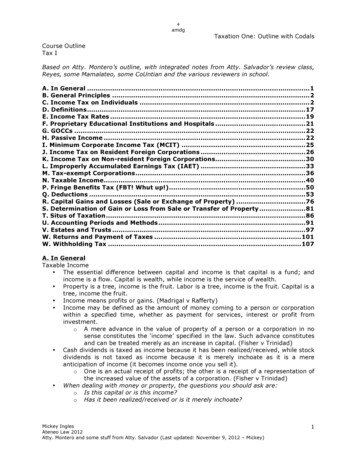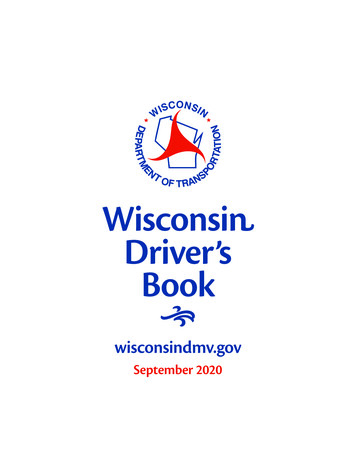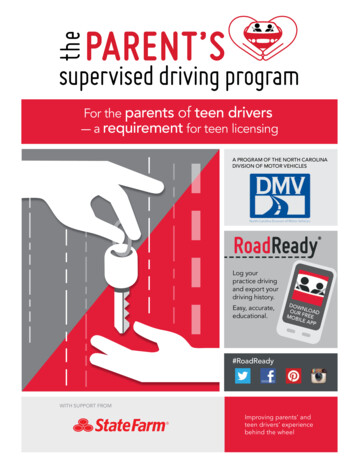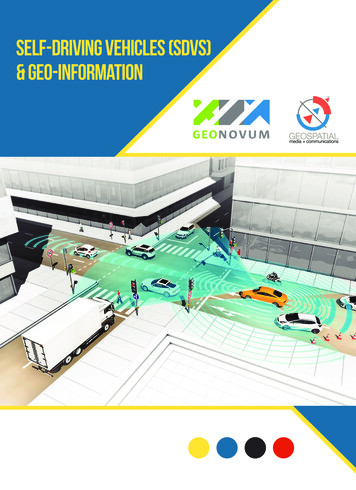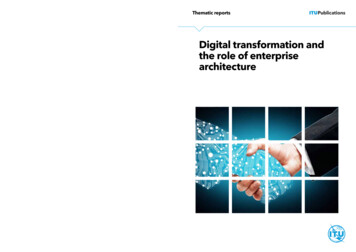
Transcription
Business white paper THE INSIGHTS DRIVING CITIZENCONTACT CENTRE TRANSFORMATIONUnlocking the value in police and public sector contact centre data
Business white paperPage 2INTRODUCTIONCONTENTS2 INTRODUCTION3 CASE STUDY:LANCASHIRE CONSTABULARY4 THE CHALLENGES FOR PUBLICSECTOR CONTACT CENTRES4 Managing demand4 Fraud and risk5 Quality of service5 Duty of care6 Regulatory compliance6 THE SOLUTION: CONVERTCONTENT TO VALUE6 GPU-accelerated speech recognition7 Voice biometrics7 Smart audio transcription8 Conversational analytics8 Flexible infrastructure8 The future is real-time9 NEXT STEPSPolice and other public sector organisations are today recording and storing an everincreasing volume of contact centre audio data from telephony and other sources. Thisdata presents particular processing challenges because it is highly sensitive, and often,time-critical. Traditionally, voice-based content has been viewed as a cost rather than asource of valuable insight. Today, this data has the potential to reveal knowledge that canimprove service quality, resource management, reduce fraud risk, provide healthier workenvironments, and more effectively manage increased customer demand.The British public depends on contact centres; they are integral to the delivery of vital publicsector services in the UK. There is huge demand for telephone-based services, despite theubiquity of the Internet; the majority of the British public (58%) still reach for the phone totalk to another person when they want answers to urgent and complex issues.1Services such as 999, 101, 111, HMRC, Jobcentre Plus, and the Driver and Vehicle LicensingAgency (DVLA) receive collectively over 100 million calls per year. Contact centres musttherefore be able to deliver critical services at scale, while facing additional pressures tooperate efficiently, reduce risks from fraud, and protect staff from undue stress.While organisations continue to recognise the value in analysing audio data, today’smulti-channel contact centres also handle video, social media and webchat communications.For example, the Metropolitan Police Service now lists online contact options on itswebsite contact page and operates around 20 social media channels including WeChatfor speakers of Chinese.However, recording conversations and converting them to text is often only the first stepin realising the value of audio content. A new generation of speech technology is turningthis data into insights that can enable contact centre transformation. Using modernanalytic techniques, operating on the output from automated speech recognition (ASR), it isnow possible to unveil important trends, patterns, and themes that were previously hiddenor difficult to access. Where ASR can be delivered at scale and speed, ideally in near-realtime, it can enable public sector organisations to be more productive and to make betterinformed decisions.The challenges faced by public sector contact centres have been brought sharply into focusby the global COVID-19 pandemic. Government protective measures, such as the closure ofbusinesses and public buildings and reduced contact among the public, has led to increasedreliance on telecommunications. Public sector contact centres are playing a more vital role indelivering services than ever before, with call volume “through the roof” according to the CallCentre Management Association.21Accenture. 2020. COVID-19: Responsive customerservice in times of change. Available oronavirus-responsive-customer-service2The Economist. 2020. Britain’s call centres areoverwhelmed and overhauling how they work.Available -how-they-work3Simmons & Simmons. 2020. Fraud in the time ofCOVID. Available id-19Additional strain is now expected as the country faces the new challenges of recession,bringing with it increasing fraud risk to all organisations that handle money.3 Speech andcommunication technologies can be used to help spot unusual patterns surroundingbusiness and individual claims, for example, and identify sentiment during conversations,allowing staff to more easily identify both positive and negative interactions.Speech and analytical technologies are ready to help public centre contact centres startusing their audio and wider data to transform operations and rise to the challenges ahead.This white paper discusses the challenges faced by public sector contact centres and howtechnologies can help solve them.
Business white paperPage 3CASE STUDY: LANCASHIRE CONSTABULARYAudio insights driving efficiencyLancashire Constabulary engaged HPE Pointnext Services to help the police gaininsight into emergency and non-emergency calls. By collaborating with HPE andpartner Intelligent Voice to build a speech-to-text analytics solution based onmachine learning, the Constabulary gained valuable statistical insights into all calls,helping the police improve efficiency and effectiveness in serving the public.Every one of the 1.2 million calls received by Lancashire Constabulary each year isrecorded, but only operational calls are formally logged. All others—about 600,000calls per year—are unlogged. These calls are referred to as ‘failure demand’, andconsequently there was no way for the police to know the nature of all those calls,or if they were handled correctly.Seeking to gain more insights into the unlogged calls, Inspector Andy Doran, a leadmember of the Futures Team, reached out to HPE Pointnext Services. “We did somework with HPE Pointnext Services previously and understood their capabilities andprofessionalism. We wanted advice on how to approach our problem, and they werevery quick to respond,” remarked Inspector Doran.HPE brought in technology experts from their Center of Excellence in Europe anddid a lot of listening to understand the Constabulary’s problem, data environment,and objectives. HPE Pointnext Services assembled a project team comprised ofcomputing engineers, data scientists, and speech-to-text experts from softwarepartner Intelligent Voice. The team built a prototype voice analytics solution, usinga sample of archived audio and worked with the Lancashire Constabulary teamto define key words and phrases that the software could listen for and extract tocreate categories.With the data extracted from the audio files, HPE Pointnext Services nextbuilt a dashboard with Lancashire Constabulary, combining approximately 20call categories with metadata such as the time and day of each call, duration,and operator ID. After the data was cleansed, it was revealed that 60% of nonemergency calls were unlogged, accounting for 40% of overall contact centreworkload. The data also showed a spike in non-emergency calls each night at10:00 p.m. Further research showed 3% of demand related to mental health cases,consuming about 5% of call centre time.Armed with these insights, Lancashire Constabulary are now able to explorealternative contact options to reduce non-emergency demand. “We alwayshave the ambition to be an outstanding police force,” says Chief Superintendent IanDawson, Head of Change at Lancashire Constabulary. “Last year we were gradedoutstanding in efficiency by Her Majesty’s Inspectorate of Constabulary, particularlyaround our ability to understand demand and utilise our funding to provide theright resources to deliver service to the public.” Intelligent Voice, partnering withHPE Pointnext Services and Lancashire Constabulary, also won the “2020 SecurityInnovation Award” for speech recognition and analysis to categorise calls.
Business white paperPage 4THE CHALLENGES FOR PUBLIC SECTOR CONTACT CENTRESManaging demandDemand on public sector contact centres changes dynamically with seasonal andunexpected events, such as times of crisis and recession. For example, in 2011 Her Majesty’sRevenue and Customs (HMRC) required 1,500 extra contact centre staff to meet atemporary spike in demand during Tax Credits renewal season.4Further, contact with public sector organisations is often more complex than with servicessuch as banking or utilities, where contact generally revolves around simple transactions.There may be multiple reasons for contact in a single conversation between a citizenand adviser; some of those reasons may be valuable and important, some less so, and aproportion will be fraudulent.Within these parameters, public sector contact centre operations more than ever needsupport to deliver effective services. In the case of 101, police forces are collecting asubstantial volume of calls where the reason for the call is not police business and shouldbe served by a partner organisation such as the local authority or National Health Service(NHS). In other cases the call cannot be serviced due to legislation, for example when acustody enquiry is made about an adult who has been detained. In the case of the UK’s999 emergency service, “around 35% of calls do not involve actual requests” for police help,emergency or otherwise.5With modern technologies, public sector contact centres can now process multi-intentcalls to discern the reasons for contact, aid advisers in handling calls more effectively, andaccurately log caller intents based on audio analysis. This delivers a more complete view ofdemand for contact centre services.Fraud and risk4Martin Lewis. 2011. Avoid tax credits hotline hell:the best times to call. Available how-to-avoid-tax-credits-hotline-hell/5BT. 2017. Facts and figures to celebrate the 80thbirthday of 999. Available of-999-113641923259056National Crime Agency. Fraud. Available at: crimethreats/fraud-and-economic-crime.7Raconteur. August 2020. Fraud & Privacy. Availableat: nal Crime Agency. Fraud. Available at: crimethreats/fraud-and-economic-crime.The National Crime Agency finds that fraud may be costing the UK public sector morethan 40 billion annually.6 All organisations that deal with money have fraud exposure andcontact centres are a major attack surface; fraud executed via contact centres has increasedby 350% over the past five years.7 Criminals are using personal and financial informationstolen in data breaches, which are a “key enabler of fraud”,8 to gain access to accountssecured by weak knowledge based authentication (KBA) systems such as passwords andsecret questions.
Business white paperPage 5Organisations in the public and private sectors have in the past depended on voicebiometrics (VB) to reduce the fraud risk and strengthen security in the authentication stepand in anti-fraud efforts. But VB has weaknesses: it requires enrolment and usually falls backon weak KBA for those who have not enrolled. VB is also ineffective in detecting previouslyunknown fraudsters, because it depends on recognition of known voices and can be trickedby voice obfuscation.Today, organisations are responding by deploying evolved fraud detection solutions thatmeasure dynamic behavioural characteristics to identify risk9 — a key example beingconversational analytics, building on speech to text technology, which seamlessly measurescharacteristics that are consistent with deceitful behaviour.Dishonest behaviours can affect the public sector in ways other than outright fraud. Hoaxcalls to the police, fire or ambulance services are made to lure staff to dangerous locations.Nuisance calls to the emergency services slow down responses to genuine needs. Usingtechnology to assess the credibility of individuals calling public sector services can help toreduce these risks.Quality of serviceMeasuring and improving service quality has become a priority for public sectororganisations. Contact centres are being asked by the UK Government’s Public ValueFramework to demonstrate value for money.10 Many call agents are in their roles to helpdeliver better outcomes for the public, which has increasingly high expectations of what thecustomer experience should be.11While positive steps have been made, research suggests organisations need furtherimprovement to effectively handle what are often complex, emotionally charged situations.A 2019 Her Majesty’s Inspectorate of Constabulary and Fire & Rescue Services (HMICFRS)inspection of police control rooms found inconsistencies in how forces resolve calls andrespond to vulnerable people.12Contact centres need to measure performance if they are to improve quality of service anddemonstrate both value for money and customer satisfaction. Organisations need a reviewor audit system that identifies instances of low customer satisfaction, so that action canbe taken, and high customer satisfaction, so that best practice can be shared and highperforming agents can be recognised.9Gartner. 2019. Market Guide for Online FraudDetection. Available rket-guide-for-online-fraud-detection10HM Treasury. 2019. The Public Value Framework.Available at: 3/public value framework andsupplementary guidance web.pdf11McKinsey. 2019. The global case for customerexperience in government. Available ence-in-government12Her Majesty’s Inspectorate of Constabulary andFire & Rescue Services. 2020. Police control roomsare in danger ofbeing overwhelmed by the demand they face.Available of-being-overwhelmed/13Acas. Supporting mental health in the workplace.Available at: rkplace14Acas. 2012. Defining an employer’s duty of care.Available at: https://archive.acas.org.uk/index.aspx?articleid 3751Duty of careProtecting the health and wellbeing of contact centre employees is a legal duty; employersneed to provide a safe working environment and take mental health issues seriously.13 Inaddition, protecting employees’ health will likely increase staff retention, boosts productivity,and improve engagement.14Callers to public sector contact centres are often in distressing or emotionally chargedsituations. Agents in police contact centres must handle calls from victims of serious andviolent crimes. Customers of Her Majesty’s Revenue and Customs (HMRC) and Departmentof Work and Pensions (DWP) contact centres may have just received bad news about theirtax affairs or benefits. Customers of the DVLA may have lost their right to drive, impactingtheir livelihood.Supporting distressed customers every day can have a substantial adverse effect onemployees’ mental health, often building up gradually over time. Modern analytics andreview technology can help organisations to fulfil their employee duty of care responsibilitiesby analysing behaviour to detect when call handlers are affected by traumatic audio, so thatthe right support can be provided; and by automating call reviews, thereby providing a saferwork environment by reducing the time staff spend listening to traumatic material.
Business white paperPage 6Regulatory complianceOne of the major implications of the introduction of new data privacy regulations in recentyears, including General Data Protection Regulation (GDPR) is that decisions made withthe help of algorithm-based technologies must be explainable and defensible. So that thoseimpacted by decisions can challenge and understand them. Solutions must offer decisionsupport and not decision automation. Customers who are impacted “by a decision supportedby an Artificial Intelligence (AI) system should be able to hold someone accountable for it.”15THE SOLUTION: CONVERT CONTENT TO VALUERapid innovation in the world of speech technology means that wherever audio contenthas the potential to reveal insight about customer needs, service quality, demand levels,or anything else an organisation needs to know, the technology is already here orrapidly emerging.Speech technologies tend to be service-and software-based and run on industry-standardserver infrastructure on premises or in the cloud. Best-fit solutions integrate speechtechnologies that solve specific challenges with infrastructure that can adapt to changingneeds and service demand levels. HPE’s approach is to partner with innovators, includingglobal speech technology leader Intelligent Voice, and integrate end-to-end solutions builton industry-leading HPE infrastructure and HPE Pointnext Services.Some of the technologies transforming contact centre operations arediscussed below.GPU-accelerated speech recognitionThe first step in unlocking the value of stored audio data is processing and preparing it foranalysis. Speech recognition is foundational for speech technology solutions; acceleratingit delivers faster insights and agent assistance, plus new capabilities such as concurrentmulti-lingual transcription.Information Commissioner’s Office. 2019.Explaining Decisions Made with AI. Available ntelligent Voice. hics processing units (GPUs) accelerate speech-to-text audio processing, on premisesor in a private cloud, at scale and without the need to transport data to public cloud services.GPUs are essentially large groups of small processors that can carry out many processingjobs at once, in parallel with the central processor. With current solutions, this parallelcomputing approach can transcribe up to 1,200 hours of audio per hour16.Processing audio on premises also means having greater control over where data residesand security policies. It can also support compliance requirements.
Business white paperPage 7Voice biometricsIt isn’t always possible or desirable to personally identify every contact centre customer. Butit is useful to identify which participant in a conversation is speaking and to locate other callsfeaturing the same speaker.Text-independent voice biometrics technology provides “attribution despite anonymity”: thepower to profile an unidentified voice, attribute utterances in a conversation to that voice,and accurately search for the same voice in other recordings.Imagine receiving a data subject access request from a customer who has called your service20 times over the past year. You have all the call recordings, but not the metadata to identifythe caller in all of them. Voice biometrics technology can search your archive and suggestthe recordings most likely to feature the customer.Consider a police investigation in which phone conversations have been lawfully interceptedacross a two-month period. Only 5 of the 400 intercepted calls involve the suspect. Usingvoice biometrics those calls are identified and crucial evidence is discovered quickly, withoutthe need for officers to spend hours reviewing recordings.Smart audio transcription“Speech to hypertext” is a useful way to think of smart audio transcription technologies,which represent an evolution of standard speech-to-text solutions. The SmartTranscriptsolution from Intelligent Voice, for example, provides clickable links within the transcript thatnavigate to the related parts of audio.More importantly, SmartTranscript can identify topics discussed in a conversation and findalerts for specified keywords. Reviewers can click topics and alerts to navigate to that partof the audio. Organisations can identify calls of interest, based on topics and keywords theydefine, and prioritise those calls for further review.Increasingly, organisations are communicating with customers and partners via webconferencing tools such as Zoom. If the organisation retains recordings of the conversations,SmartTranscript can be used to rapidly assess and review audio, as captured in these newand rapidly growing channels of communication.SmartTranscript is agile in adapting to new requirements. In a scenario where anunanticipated issue is affecting customers, such as a data breach, SmartTranscript can findall conversations where “data breach” was the topic or where the term was mentioned. Thosecalls can be reviewed faster than before because reviewers can navigate straight to the partsthat discuss the topic.The technology can also discover things that the organisation and its human call reviewerswere oblivious to. In a US jail that had deployed an Intelligent Voice machine learningsolution, the system flagged the term “three-way” as a common non-trivial phrase inprisoners’ phone calls. Prison officials later worked out that doing a “three-way” was codefor dialling a third party into the call.17New Scientist. 2016. Prisoners’ code word caughtby software that eavesdrops on calls. Available esdrops-on-calls/17
Business white paperPage 8Conversational analyticsConversational analytics, such as that delivered by Intelligent Voice’s LexiQal product,identifies behavioural characteristics of speakers in recorded speech. The analysis providesinsights into the speaker’s credibility, emotional state or behavioural changes that aresignificant in context, as well as the sentiment behind what is said, with a high degree ofaccuracy at utterance level. The insights are valuable across both sides of the call, agentand customer alike, and support use cases such as fraud detection and measuring customersatisfaction levels. LexiQal was developed with funding from UK Research and Innovation(UKRI); ongoing research aims to improve its efficiency, automation, and transparency.Conversational analytics works by detecting patterns in speech via markers, such asanswering a question with a question, hesitations or answering questions too slowly. Thetechnology automatically identifies these conversational features, weighs their significance,and makes recommendations. Recommendations should only be used to inform humanmade decisions to act or not.Flexible infrastructure“Pay-as-you-use” IT as a service solutions, such as HPE GreenLake cloud services, areenabling public sector organisations to deploy agile speech technology solutions withoutthe need to purchase expensive hardware. HPE GreenLake delivers cloud economics onpremises, a pay-per-use model with no capital needed up front, and no overprovisioningof infrastructure, which is better aligned with business outcomes. The solution providesmanaged on-premises infrastructure, supporting regulatory compliance needs and providingcontrol over data and security. Customers can scale infrastructure flexibly as servicedemand changes.The future is real-timeSpeech technologies are getting faster with every generation. Because of the growing powerof GPU technology and significant recent advances in speech recognition algorithms, realtime speech processing and analytics for sensitive client data is now coming on stream ona commercial basis in the data centre. Real-time speech analytics will provide actionableinsights during a live call, both assisting agents and alerting supervisors when theirintervention is needed.
Business white paperNEXT STEPSPublic sector contact centres deliver essential services to millions of people across the UK.The challenges faced by these contact centres are the challenges faced by the world—theyare social, financial, unpredictable, fast-changing, and highly demanding.Contact centres must keep adapting and growing in capability to meet increased demandand tackle new problems. Organisations are already collecting the audio data they need. Byemploying speech technologies, they can put that data to work and extract the value within,learning more about citizens’ needs, their own performance, where resources are beingwasted, and how to protect against risk.Speech technology solutions are increasingly accessible. They run on industry-standardservers. Organisations do not need to design or run them alone, but can deploy flexible,managed, pay-as-you-use solutions by partnering with experts such as Intelligent Voiceand HPE.By talking to experts, organisations can assess opportunities available to them and accessthe best speech technologies on which to build the next generation of public sector contactcentre services.LEARN MORE ATMake the right purchase decision.Contact our presales specialists.ChatEmail utions/public-sector-industriesCallGet updates Copyright 2020 Hewlett Packard Enterprise Development LP. The information contained herein is subject to change withoutnotice. The only warranties for Hewlett Packard Enterprise products and services are set forth in the express warranty statementsaccompanying such products and services. Nothing herein should be construed as constituting an additional warranty.Hewlett Packard Enterprise shall not be liable for technical or editorial errors or omissions contained herein.All third-party marks are property of their respective ownersa00106782eew, October 2020
Speech and analytical technologies are ready to help public centre contact centres start using their audio and wider data to transform operations and rise to the challenges ahead. This white paper discusses the challenges faced by public sector contact centres and how technologies can help



